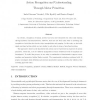Free Online Productivity Tools
i2Speak
i2Symbol
i2OCR
iTex2Img
iWeb2Print
iWeb2Shot
i2Type
iPdf2Split
iPdf2Merge
i2Bopomofo
i2Arabic
i2Style
i2Image
i2PDF
iLatex2Rtf
Sci2ools
AR
2007
2007
Action recognition and understanding through motor primitives
In robotics, recognition of human activity has been used extensively for robot task learning through imitation and demonstration. However, there has not been much work on modeling and recognition of activities that involve object manipulation and grasping. In this work, we deal with single arm/hand actions which are very similar to each other in terms of arm/hand motions. The approach is based on the hypothesis that actions can be represented as sequences of motion primitives. Given this, a set of 5 different manipulation actions of different levels of complexity are investigated. To model the process, we are using a combination of discriminative support vector machines and generative hidden Markov models. The experimental evaluation, performed with 10 people, investigates both definition and structure of primitive motions as well as the validity of the modeling approach taken.
| Added | 08 Dec 2010 |
| Updated | 08 Dec 2010 |
| Type | Journal |
| Year | 2007 |
| Where | AR |
| Authors | Isabel Serrano Vicente, Ville Kyrki, Danica Kragic, Martin Larsson |
Comments (0)

